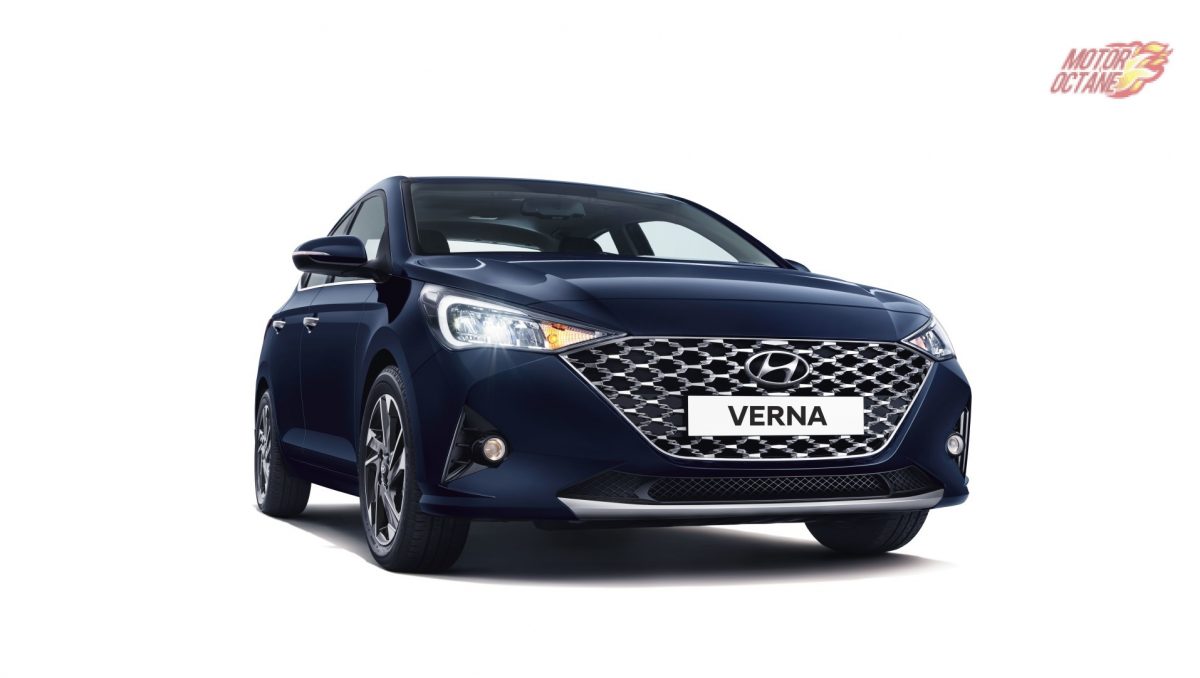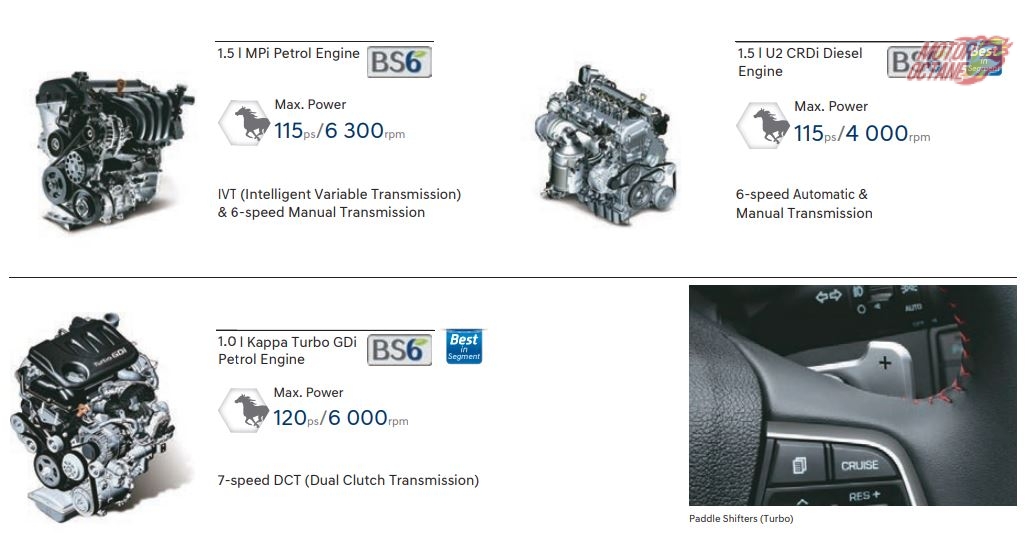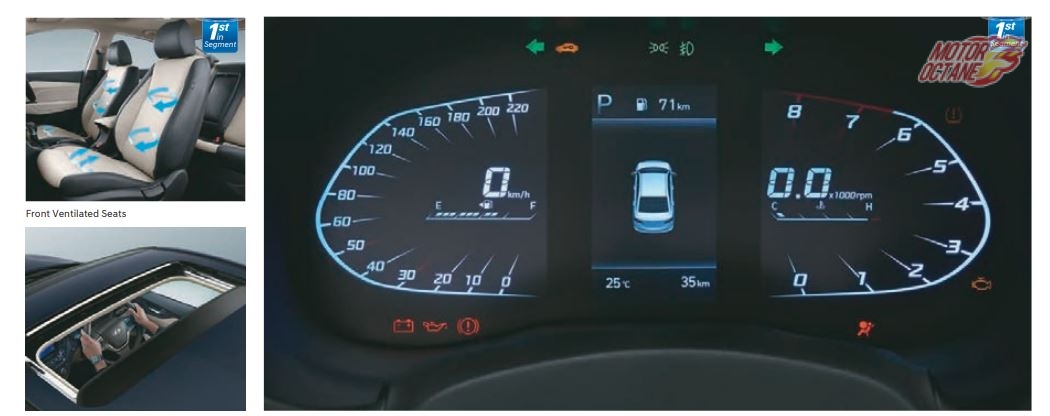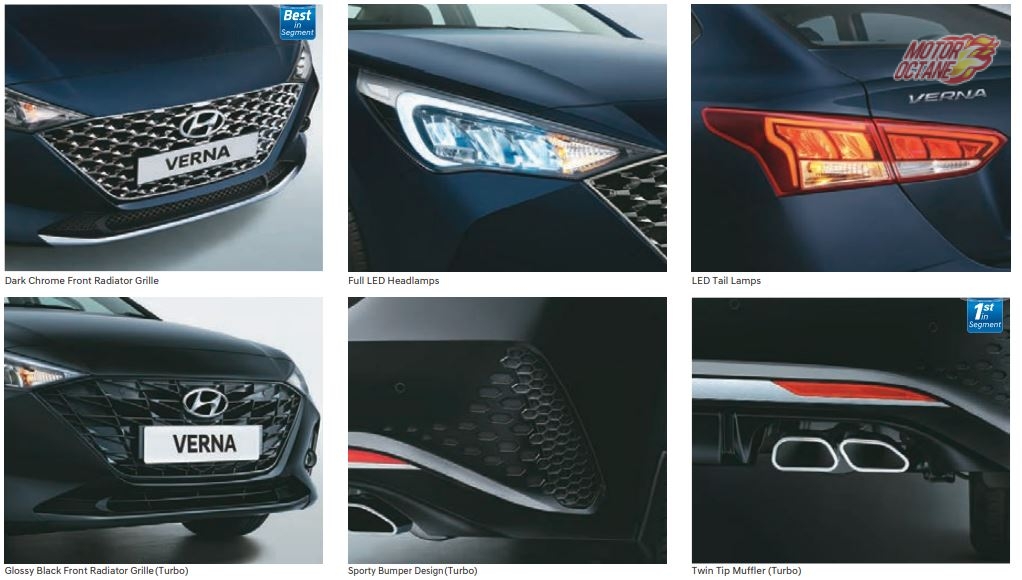New Hyundai Verna Variants – Which is for you?

Hyundai has launched the facelift of Verna today. The car has a starting price of Rs 9.3 lakhs. In this article, we take a look at the features offered on each variant of the new Hyundai Verna and also the pricing structure of the car overall.
Engine Options
The new Hyundai Verna engine comes in 3 configurations. There are 2 petrol engines and one diesel engine. The diesel engine is a 1.5-litre engine whereas it gets a 1.0-litre turbo engine along with the 1.5-litre petrol engine.

The petrol engine comes with a power of 115 bhp at 6300 rpm. It gets an iVT which is a form of CVT transmission system. The manual transmission is a 6-speed manual gearbox. The Hyundai Verna diesel engine also produces a maximum power of 115 bhp. But this comes lower in the rev-band at 4000 rpm. This makes it more tractable and a better choice over the petrol engine.
| Engine | Maximum Power (PS @ rpm) | Maximum Torque (kgm @ rpm) |
Transmission |
| 1.5 Litre
Petrol BS 6 |
115ps @ 6,300rpm | 14.7kgm @ 4,500rpm | 6 MT/IVT |
| 1.5 Litre
Diesel BS 6 |
115ps @ 4,000rpm | 25.5kgm @ 1500~2750rpm | 6MT/AT |
| 1.0 Litre Turbo GDI BS 6 | 120ps @ 6,000rpm | 17.5kgm @ 1,500~4000rpm | 7DCT |
Lastly, the 1.0 kappa turbo engine on the Hyundai Verna 2020 has a power of 120 bhp. This is only 15 bhp more than the naturally aspirated petrol variant but it comes higher in the rev-band at 6000rpm. Also, it is equipped with a DCT transmission. This allows quick shifts and there are paddle shifters to aid this. The new Hyundai Verna BS6 engine is refined and compliant with the new emission norms. This engine will be exclusive for India.
New Hyundai Verna Variants
In all, the new Hyundai Verna gets 5 variants. But there are 8 options to choose from with different engine options. If we only consider there are 11 Hyundai Verna prices to choose from. Now if you are a customer who wants a peppy engine and has a good budget to spare then the Rs 13.9 lakhs variant is for you. This is the SX(O) Turbo DCT. The SX(O) variant is the top for the other two engines. The Automatic gearbox on these cars makes for the top highest priced variant.
| S | S+ | SX | SX IVT | SX AT | SX(O) | SX(O) IVT | SX(O) AT | SX(O) Turbo DCT | |
| 1.5 Litre
Petrol |
930585 | – | 1070389 | 1195389 | – | 1259900 | 1384900 | – | – |
| 1.5 Litre
Diesel |
– | 1065585 | 1205389 | – | 1320389 | 1394900 | – | 1509900 | – |
| 1.0 Litre Turbo GDI | – | – | – | – | – | – | – | – | 1399000 |
The diesel is priced at Rs 15.09 lakhs. This is even more feature-packed than the Turbo DCT variant. If you want a good top-end car with all features and Automatic then the SX(O) petrol makes a great choice at Rs 13.84 lakhs.

The other variants of the new Hyundai Verna are the S and SX. The S is the base petrol manual and the S+ is the base diesel manual. This variant is good if you want to buy the car and put it for commercial use. The SX offers slightly more features and also the option of Automatic along with Manual.
Hyundai Verna BlueLink
There are 5 BlueLink Safety features on the car. These include Auto Crash Notifications, SOS and RSA. The Panic Notification and Low tyre Pressure information are soft features to prevent accidents. Also in terms of prevention, the car gets 3 security features. These are the Stolen vehicle tracking, Immobilization and Notification system.

The BlueLink system comes with a few fancy features on the Automatic version of the new Hyundai Verna. The coolest is the remote engine start-stop and remote AC control and pre-cooling. The car also has a remote door lock unlock and other remote functions which could be done with the key previously. There are 4 features for the smartwatch. With a BlueLink Smartwatch face. Also with the Remote controls and vehicle alerts. The BlueLink gets voice recognition and other voice-assisted features.
We will come with a more in-depth description of the Variants and pricing structure soon. Let us know in the comments what would you like to read more on this new Hyundai Verna. Also take a look at the Hyundai Creta Variants and Features Detailed Explanation

Very poorly structured article. Not much valuable information provided.